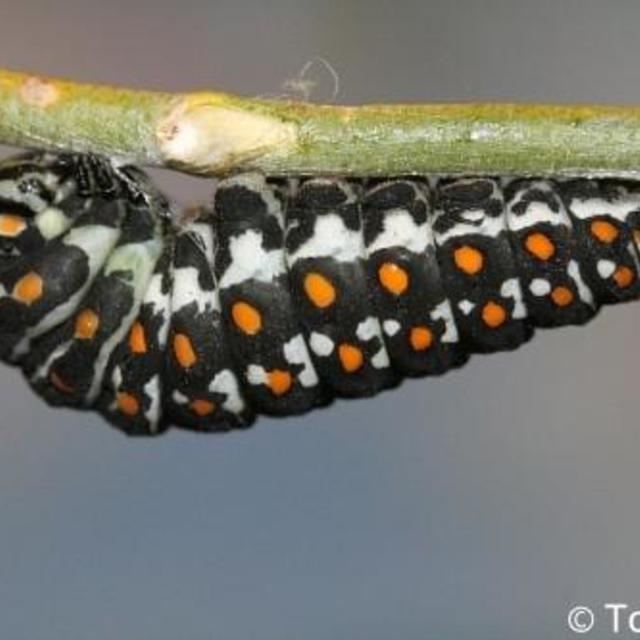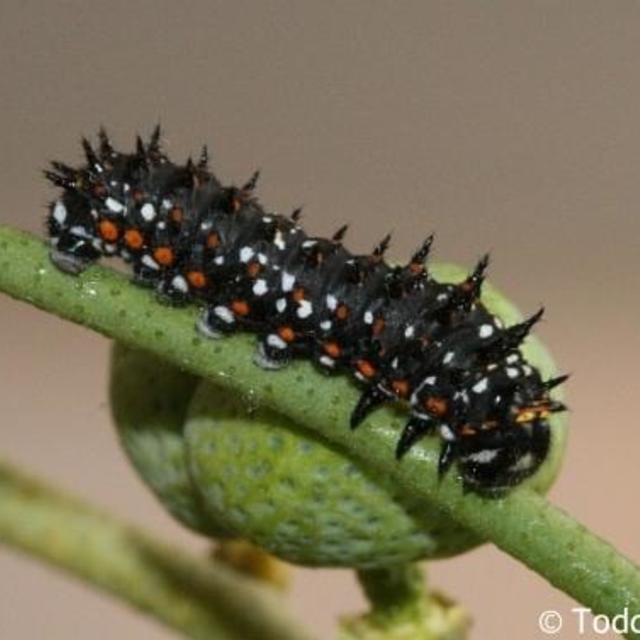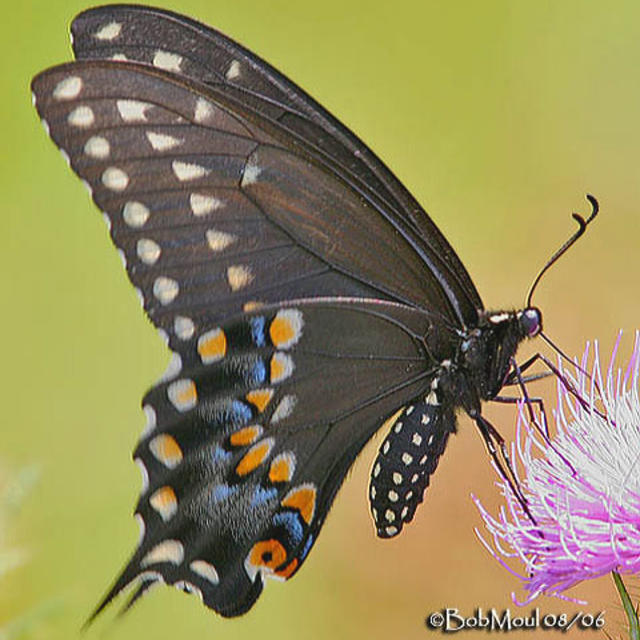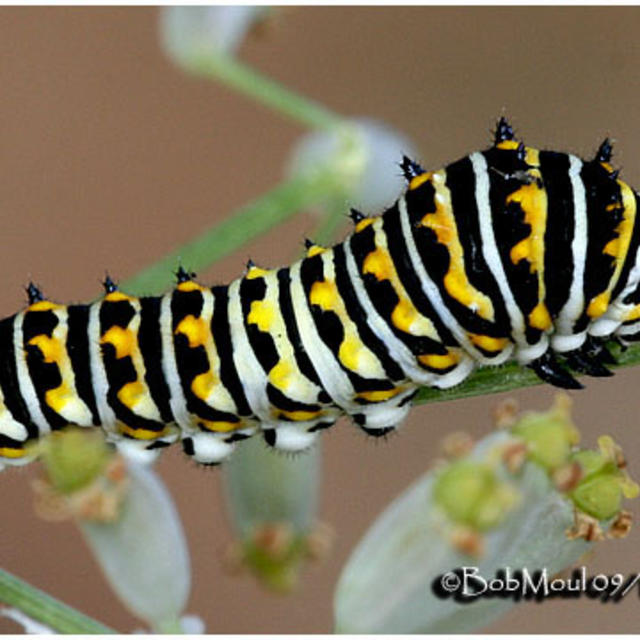Black Swallowtail
Papilio polyxenes Fabricius, 1775
Family: Papilionidae
Subfamily: Papilioninae
Identification: Upper surface of wings mostly black; on inner edge of hindwing is a black spot centered in larger orange spot. Male has yellow band near edge of wings; female has row of yellow spots. Female hindwing with iridescent blue band. In the Southwest, yellow forms predominate in the subspecies P. coloro.
Wing Span: 3 1/4 - 4 1/4 inches (8 - 11 cm).
Life History: Males perch and patrol for receptive females. Female lays eggs singly on leaves and flowers of the host, which are then eaten by hatching larvae. Hibernates as a chrysalis.
Flight: One-2 flights from April-October in northern regions of range; 3 flights in southern regions.
Caterpillar Hosts: Leaves of plants in the parsley family (Apiaceae) including Queen Anne's Lace, carrot, celery and dill. Sometimes plants in the citrus family (Rutaceae) are preferred.
Adult Food: Nectar from flowers including red clover, milkweed, and thistles.
Habitat: A variety of open areas including fields, suburbs, marshes, deserts, and roadsides.
Range: Most of the eastern U.S., north into Quebec, west into s. Saskatchewan, Colorado and se. California; south to n. South America. Subspecies coloro in desert Southwest.
Conservation: Not usually of concern.
NCGR: G5 - Demonstrably secure globally, though it may be quite rare in parts of its range, especially at the periphery.
Management Needs: Maintain open fields in East.
Get your BAMONA Gear!
Please donate!
We depend on donations to keep Butterflies and Moths of North America freely available. We want to express our gratitude to all who showed their support by making a contribution this year. You can donate to support this project at any time.
Advertise with us!
Do you have a product or service that you think would interest BAMONA users? If you would like to advertise on this website, contact us by email, or use the contact form and select the "Advertising" category.
Verified Sightings
Displaying 49 - 72 of 9741 verified sightings

Observation date: Jul 17, 2024
Submitted by: jwileyrains
Region: Litchfield County, Connecticut, United States
Verified by: jwileyrains
Verified date: Jul 19, 2024

Observation date: Jul 18, 2024
Submitted by: jwileyrains
Region: Litchfield County, Connecticut, United States
Verified by: jwileyrains
Verified date: Jul 19, 2024

Observation date: Jul 18, 2024
Submitted by: ElaineF
Region: New Brunswick, Canada
Verified by: jwileyrains
Verified date: Jul 18, 2024

Observation date: Jul 17, 2024
Submitted by: EvanMacD
Region: New Brunswick, Canada
Verified by: jwileyrains
Verified date: Jul 17, 2024

Observation date: Jul 08, 2024
Submitted by: zbeckb
Region: Hamilton County, Indiana, United States
Verified by: rogerdowner
Verified date: Jul 16, 2024

Observation date: Jul 10, 2024
Submitted by: Bombyx-Aurelia
Region: Quebec, Canada
Verified by: jmgesell
Verified date: Jul 16, 2024

Observation date: Sep 21, 2022
Submitted by: Hazem255
Region: Will County, Illinois, United States
Verified by: rogerdowner
Verified date: Jul 15, 2024

Observation date: Jul 13, 2024
Submitted by: Hazem255
Region: Cook County, Illinois, United States
Verified by: rogerdowner
Verified date: Jul 15, 2024

Observation date: Jul 10, 2024
Submitted by: jwileyrains
Region: Litchfield County, Connecticut, United States
Verified by: jwileyrains
Verified date: Jul 12, 2024

Observation date: Jul 05, 2024
Submitted by: lmsmith7677
Region: Clay County, Alabama, United States
Verified by: stomlins701
Verified date: Jul 11, 2024

Observation date: Jun 28, 2024
Submitted by: Benjamin Miller
Region: Knox County, Ohio, United States
Verified by: rogerdowner
Verified date: Jul 05, 2024

Observation date: Jul 04, 2024
Submitted by: Killer Bunny
Region: Ontario, Canada
Verified by: curtis.lehman
Verified date: Jul 05, 2024

Observation date: Jun 29, 2024
Submitted by: mtobin11
Region: Cook County, Illinois, United States
Verified by: rogerdowner
Verified date: Jul 03, 2024

Observation date: May 25, 2024
Submitted by: ktronic
Region: Texas, Kerr County, United States
Verified by: stomlins701
Verified date: Jul 02, 2024

Observation date: Jun 17, 2024
Submitted by: houdini73
Region: Brown County, Texas, United States
Verified by: stomlins701
Verified date: Jul 02, 2024

Observation date: Jun 03, 2024
Submitted by: jennb1973
Region: Comal County, Texas, United States
Verified by: stomlins701
Verified date: Jul 02, 2024

Observation date: Jun 21, 2024
Submitted by: jennb1973
Region: Comal County, Texas, United States
Verified by: stomlins701
Verified date: Jul 02, 2024

Observation date: Jun 17, 2024
Submitted by: bekkfree
Region: Cowley County, Kansas, United States
Verified by: James Steen
Verified date: Jul 01, 2024

Observation date: Jun 24, 2024
Submitted by: Lydiaak
Region: Allegheny County, Pennsylvania, United States
Verified by: davidwright
Verified date: Jul 01, 2024

Observation date: Jun 30, 2024
Submitted by: GLG
Region: Walton County, Florida, United States
Verified by: John Calhoun
Verified date: Jun 30, 2024

Observation date: Jun 24, 2024
Submitted by: EMB
Region: Franklin County, Ohio, United States
Verified by: rogerdowner
Verified date: Jun 29, 2024

Observation date: Jun 25, 2024
Submitted by: Selwyn Quan
Region: Santa Clara County, California, United States
Verified by: Ken Davenport
Verified date: Jun 26, 2024

Observation date: Jun 24, 2024
Submitted by: Lydiaak
Region: Allegheny County, Pennsylvania, United States
Verified by: davidwright
Verified date: Jun 25, 2024

Observation date: Jun 21, 2024
Submitted by: seemayer
Region: Sedgwick County, Kansas, United States
Verified by: James Steen
Verified date: Jun 22, 2024
- ‹ previous
- 3 of 406
- next ›






































